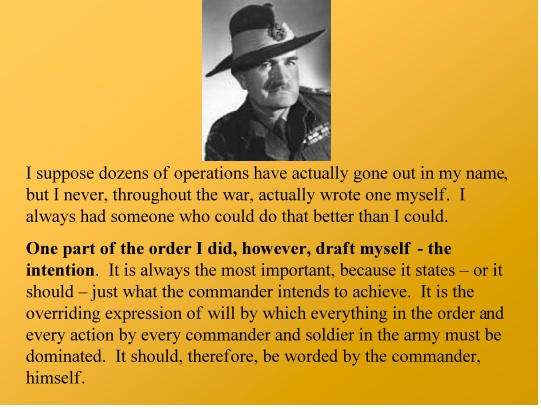Tactics 101: 027. Commander’s Intent
COMMANDER’S INTENT – IT’S A PERSONAL THING
Although it seems like a given – a commander’s intent must be written by the commander. It’s simple; dissect the words – commander’s intent. It does not say executive officer’s (XO) intent or operations officer’s (S3) intent. It says commander’s intent. A commander who tasks one of his staff officers to write his intent is simply a commander on paper. As mentioned earlier in our review of FM 3-0 (2008), “Commanders develop their intent statement personally.”
Perhaps British Field Marshal William Slim, one of World War II’s greatest leaders said it best regarding the topic. He stated:

REVIEW
Commander’s intent is a powerful tool when communicated effectively and understood by subordinates. It enables those subordinates to exercise initiative and take advantage of opportunities on the battlefield (as long as they assist in achieving mission accomplishment). It should not be long or contain flowery language that matters little on the battlefield. When the fog of war settles on the battlefield (as it ultimately will), it is a concise, meaningful intent that Soldiers will remember.
Commander’s Intent (WHAT IT IS):
Is a clear and concise statement
Describes what the force must do to be successful
Describes the conditions the force must meet
Describes an end state which defines success is in terms of friendly forces, enemy, terrain, and civil considerations
Focuses the efforts of the staff and subordinates in developing plans and orders.
Written by the commander himself
Commander’s Intent (WHAT IT IS NOT):
A template
A course of action
Tied to a specific course of action
Describe the method of getting from point A to the desired end state
Address acceptable risk
Commander’s Intent is not a template found in an SOP book.
It is not a Course of Action (COA) nor is it tied to a specific COA.
The method is the Concept of the Operation.
Risk is addressed in Commander’s Guidance and in each COA developed
NEXT MONTH
We will continue next month with another powerful tool the commander has at his disposal – commander’s guidance. A well-though out and delivered guidance early in the planning process sets the conditions for mission success. On the other hand, poor guidance or no guidance by the commander leads to an event commonly called a flail-ex!! See you next month!


The first bullet point in the intent should be eliminated, as what forces are in our path is of “special interests” not ours.
Last thing we need is to grabbing ourselves because we are up against the Republican or Special Republican Guard.
Great article otherwise!
Re commander’s intent: nice to see that this surprisingly modern management concept, which is over a hundred years old, is getting the wide acceptance it deserves.
I have a couple of questions, though!
First question: How is ‘commander’s intent’ different from ‘mission’? Cannot /shouldn’t it be integrated?
Second question: if in your example on page 2 there had been two instead of one scout sergeant, positioned on the opposite flanks of the battalion’s advance and they had both assessed the situation and radioed in to remedy the advance but towards their own (respective) positions, how would that situation be resolved? Company commander who receives the radio call decides, battalion decides?
Mission: toss bad guys out of zone
Intent:
-and not get lost while doing this
-and conserve force
-and do this in 24 hours.
-etc.
You could integrate these concepts – but reasons are given to make a more complete, personal statement.
Re: 2 courses of action available to subordinate commander.
The man on the spot ( Company commander ) decides – given that Battalion Commander had already stated his intent, and that at least one of the 2 scouts was out of contact with TF command anyway.
The idea here is that you and your Command can keep going even if Comms are inoperative. Sherman and Grant would not necessarily be able to communicate with each other anyway.
Hello. I want to ask concerning one of MDMP step- WARAMING. How to create Decision Support template and Decision Support Matrix?
Thanks.
Best regards.